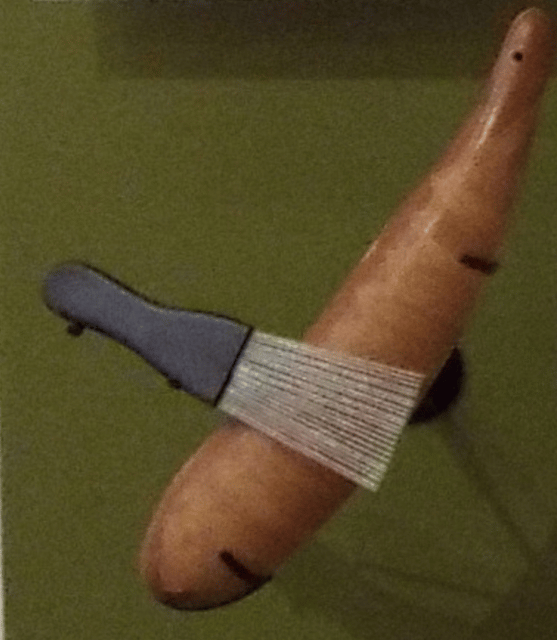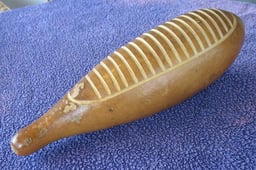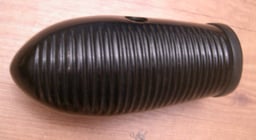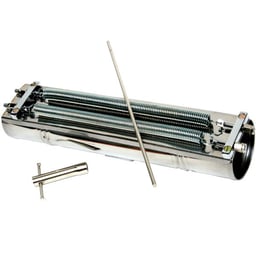Güiro

Güiro

| Percussion instrument | |
|---|---|
| Other names | Rascador, güícharo, candungo, carracho, rayo |
| Classification | Idiophone, could be made from wood, gourd, metal, plastic or fiberglass |
| Hornbostel–Sachs classification | 112.23 (Scraped idiophone, vessel) |
| Playing range | |
| Speed of scrape produces some variation | |
| Related instruments | |
| Güira, guayo, guacharaca, reco-reco, quijada, washboard | |
The güiro (Spanish pronunciation: [ˈɡwiɾo]) is a Latin American percussion instrument consisting of an open-ended, hollow gourd with parallel notches cut in one side. It is played by rubbing a stick or tines along the notches to produce a ratchet sound.[1]
The güiro is commonly used in Puerto Rican, Cuban and other forms of Latin American music, and plays a key role in the typical rhythm section of important genres like son, trova and salsa. Playing the güiro usually requires both long and short sounds, made by scraping up and down in long or short strokes.[2]
The güiro, like the maracas, is often played by a singer. It is closely related to the Cuban guayo and the Dominican güira, which are made of metal. Other instruments similar to the güiro are the Colombian guacharaca, the Brazilian reco-reco, the quijada (cow jawbone) and the frottoir (washboard).[2]
| Percussion instrument | |
|---|---|
| Other names | Rascador, güícharo, candungo, carracho, rayo |
| Classification | Idiophone, could be made from wood, gourd, metal, plastic or fiberglass |
| Hornbostel–Sachs classification | 112.23 (Scraped idiophone, vessel) |
| Playing range | |
| Speed of scrape produces some variation | |
| Related instruments | |
| Güira, guayo, guacharaca, reco-reco, quijada, washboard | |
Etymology
In the Arawakan language, a language of the indigenous people of Latin America and spread throughout the Caribbean spoken by groups such as the Taíno, güiro referred to fruit of the güira and an instrument made from fruit of the güira.[3]
Construction and design
History
The güiro was adapted from an instrument which might have originated in either South America or Africa.[2] The Aztecs produced an early cousin to the güiro, called the omitzicahuastli which was created from a small bone with serrated notches and was played in the same manner as the güiro.[7] The Taíno people of the Caribbean have been credited with the origins of the güiro.[8] The Taínos of Puerto Rico developed the güajey, a long gourd or animal bones with notches, was an antecedent of the modern day güiro.[9] The güiro is also believed to have origins in Africa and brought over to Latin American and the Caribbean by African slaves.[10]
Use in music
Across Latin American and the Caribbean, the güiro can be found in a variety of traditional, folk dance music and used in dance ensembles and religious festivals.[6] In the Yucatan Peninsula, the güiro is used in two Mayan dances, the mayapax and the jarana.[8] In Cuba, the güiro is used in the genre danzón.[8] In Puerto Rico, the güiro often associated with the music of the jíbaro and is used in the musical genres of the plena, the seis, and the danza.[9][11] In the Caribbean coast, the güiro was used in traditional, folk dance cumbia music and is still used in modern cumbia music.[8] In Panama, the güiro can be found in folk dances such as the merjorana and cumbia.[6]
Use in classical music
The güiro is used in classical music both to add Latin American flavor, and also purely for its instrumental qualities.
Examples of compositions including a güiro are Uirapuru by Heitor Villa-Lobos (though the score specifies reco-reco), Latin-American Symphonette by Morton Gould and The Rite of Spring (Le Sacre du printemps) by Stravinsky.[12]







